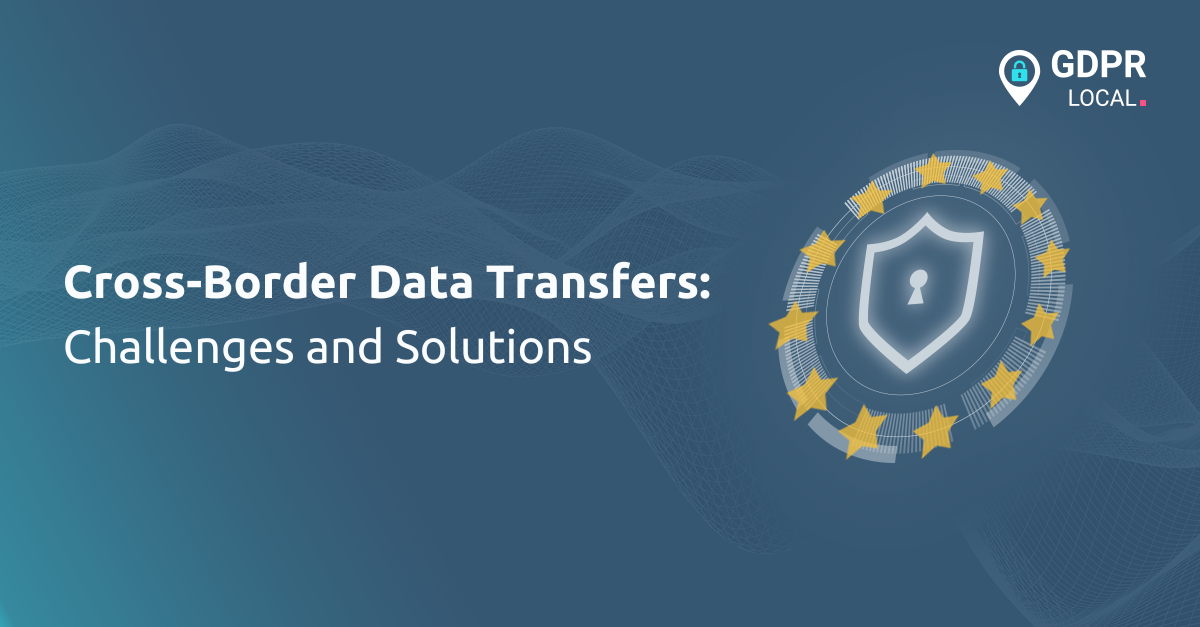
Cross-Border Data Transfers: Challenges and Solutions
Updated, June 2025
Companies face the challenge of protecting sensitive information and ensuring compliance with privacy regulations when transferring data across borders. The GDPR of the European Union (EU) has set a high standard for data protection and has become the benchmark for compliance in this area. To ensure GDPR compliance, companies must understand the challenges involved and implement effective solutions for cross-border data transfers.
Here, we examine the challenges and solutions for ensuring compliance and security in cross-border data transfers following the GDPR.
Key Takeaways
Legal Basis is Mandatory: Organisations cannot transfer personal data outside the EU without a valid legal mechanism. Key methods include adequacy decisions, where the EU has pre-approved a country’s data protection laws, and implementing “appropriate safeguards,” such as Standard Contractual Clauses (SCCs) and Binding Corporate Rules (BCRs).
Accountability and Security are Paramount: Companies must implement robust technical and organisational measures, such as strong encryption and regular security audits, to protect data during transfers. They must also maintain detailed records of all cross-border data transfers to demonstrate compliance with the GDPR to the relevant authorities.
Risk Assessment is Crucial: Before transferring data, organisations should conduct a Data Protection Impact Assessment (DPIA) to identify and mitigate privacy risks. This is especially important for high-risk data transfers and helps ensure that the recipient country’s laws and practices do not undermine the protections guaranteed by GDPR.
Understanding Cross-Border Data Transfers
What are Cross-Border Data Transfers?
Cross-border data transfers involve the sharing of personal data between two national jurisdictions. Seamless data exchange across borders is crucial for businesses to innovate and drive economic growth. However, various jurisdictions have implemented data protection laws to regulate this process, ensuring the privacy and security of individuals’ personal information. These laws aim to protect national security, prevent the misuse of personal data, and strengthen domestic economic capabilities.
The Importance of GDPR in Cross-Border Data Transfers
The GDPR is a comprehensive data protection regulation that applies to all EU member states and has extraterritorial reach. It sets high standards for the processing and transfer of personal data, regardless of where the data originates or where it is transferred. The GDPR aims to protect the fundamental rights and freedoms of individuals and harmonise data protection laws across the EU. It mandates strict obligations on organisations, including obtaining consent, implementing measures, and ensuring data security during cross-border transfers.
Challenges of Cross-Border Data Transfers
Transferring personal data across borders poses several challenges for organisations. Understanding these challenges is crucial for developing effective strategies to ensure compliance and protect sensitive information.
Data Security
Data breaches can have severe consequences for individuals and organisations. Companies must take appropriate measures to protect personal data during cross-border transfers, both in transit and at rest. Good encryption, access controls, and regular security audits are vital to safeguard sensitive information from unauthorised access
Differing Data Protection Laws
Data protection laws vary across countries, making it challenging for organisations to operate the compliance part of their business. While the GDPR sets high standards for data protection within the EU, other countries may have different requirements. Companies must ensure that third-party recipients abroad meet GDPR standards and comply with the specific data protection laws in their jurisdiction.
Legal Basis for Transfers
Under the GDPR, organisations must have a valid legal basis for transferring personal data outside the EU. The most common legal bases include obtaining explicit consent from individuals, entering into standard contractual clauses (SCCs) with third-party recipients, employing binding corporate rules (BCRs) within multinational corporations, or relying on adequacy decisions by the European Commission for transfers to countries with an adequate level of data protection.
Accountability and Documentation
The GDPR places a significant emphasis on accountability and documentation. Organisations must maintain detailed records of cross-border data transfers, including the categories of personal data, the purposes of the transfers, the countries involved, and the legal basis.
These records demonstrate compliance with the GDPR and enable organisations to respond to inquiries from data protection authorities.
Ensuring GDPR Compliance in Cross-Border Data Transfers
To ensure GDPR compliance in cross-border data transfers, organisations must employ a multi-faceted approach that combines legal, technical, and organisational measures. Here are some key strategies and best practices to consider:
Conduct a Data Protection Impact Assessment (DPIA)
A DPIA is a systematic process to identify and minimise privacy risks associated with data processing activities. It is particularly important when initiating new projects or when the processing involves high-risk data. By conducting a DPIA, organisations can assess the potential impact on individuals’ privacy and implement appropriate measures to mitigate risks and ensure compliance with the GDPR.
Implement Technical and Organisational Measures
Organisations should implement appropriate technical and organisational measures to protect personal data during cross-border transfers. This includes robust encryption practices, access controls, and regular security audits to identify and address vulnerabilities. By adopting a comprehensive approach to data security, organisations can minimise the risk of data breaches and demonstrate their commitment to protecting sensitive information.
Use Standard Contractual Clauses (SCCs)
SCCs are model contract clauses approved by the European Commission that organisations can use for transferring personal data to countries outside the EU. By including SCCs in contracts with third-party data recipients, organisations can ensure that adequate data protection measures are in place and meet the GDPR’s requirements for cross-border transfers.
Employ Binding Corporate Rules (BCRs)
BCRs are internal policies that govern the handling of personal data within multinational corporations. They provide a framework for organisations to transfer personal data between entities within the same corporate group, ensuring consistent and high-level data protection standards. BCRs require approval from data protection authorities and demonstrate a commitment to GDPR compliance across the organisation.
Consider Data Protection Certification Mechanisms
Data protection certification mechanisms, approved by relevant authorities, can provide organisations with an additional layer of assurance in demonstrating GDPR compliance. Certification schemes help organisations show they’ve implemented measures to protect personal data during cross-border transfers.
Certification mechanisms typically have a maximum validity of three years and require regular renewal.
Obtain Explicit Consent
When transferring personal data outside the EU, organisations may rely on explicit consent as a legal basis for the transfer. It is essential to obtain informed and freely given consent from individuals, ensuring they understand the purpose and risks associated with the transfer. Organisations should provide clear information about the data transfer, the countries involved, and any potential risks to individuals’ rights and freedoms.
Maintain Detailed Records
To demonstrate GDPR compliance, organisations must maintain detailed records of their cross-border data transfers. These records should include information such as the categories of personal data transferred, the purpose of the transfer, the countries involved, the legal basis for the transfer, and any additional safeguards implemented. Comprehensive records enable organisations to respond effectively to inquiries from data protection authorities and demonstrate accountability.
The Future of Cross-Border Data Transfers
As technology advances and global data flows continue to increase, the future of cross-border data transfers following the GDPR will likely involve further developments in data protection laws and regulations. Organisations must stay informed about emerging requirements and adapt their data transfer practices accordingly. It is crucial to monitor regulatory changes, engage in ongoing compliance efforts, and seek professional guidance to ensure compliance with evolving data protection standards.

How GDPRLocal Can Help
With our expertise and in-depth understanding of the GDPR and global data protection laws, we empower businesses to achieve and maintain compliance while securely transferring personal data across borders.
Our team of experienced professionals works closely with organisations to assess their data transfer practices, identify compliance gaps, and develop tailored strategies to ensure GDPR compliance. We provide guidance on legal frameworks, assist in implementing technical and organisational measures, and offer ongoing support to help organisations navigate the evolving data protection landscape.
Partner with us to mitigate cross-border data transfer risks, enhance security, and foster trust with stakeholders. Our holistic GDPR compliance approach allows focus on core business while ensuring data privacy and protection.
Conclusion
Cross-border data transfers post-GDPR present significant challenges for organisations, requiring them to navigate complex legal requirements and implement robust data protection measures. By understanding the challenges involved and adopting the strategies and best practices outlined in this guide, organisations can ensure GDPR compliance, protect sensitive information, and build trust with their stakeholders.
Contact us today to learn how we can help your organisation face the challenges of cross-border data transfers and achieve GDPR compliance.
FAQs
What are the main legal mechanisms for transferring data outside the EU?
Organisations must use a valid legal basis, such as an adequacy decision for a pre-approved country, Standard Contractual Clauses (SCCs), which are model contracts, Binding Corporate Rules (BCRs) for internal group transfers, or explicit and informed consent from the individual.
2. What is the difference between Standard Contractual Clauses (SCCs) and Binding Corporate Rules (BCRs)?
SCCs are standardised, pre-approved contracts for transferring data to any external organisation outside the EU, while BCRs are customised, internal policies that allow multinational corporations to transfer data within their own group after a rigorous approval process by regulators.
3. What happens if a company fails to comply with GDPR’s cross-border data transfer rules?
Non-compliance can result in severe consequences, including significant fines of up to €20 million or 4% of global annual turnover, regulatory orders to stop data transfers, which can halt business operations, and potential legal action from individuals whose data rights were violated.